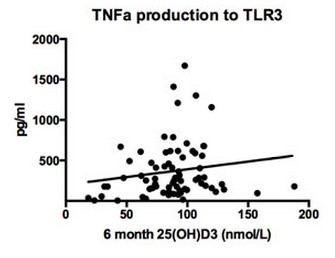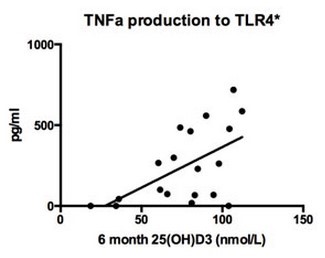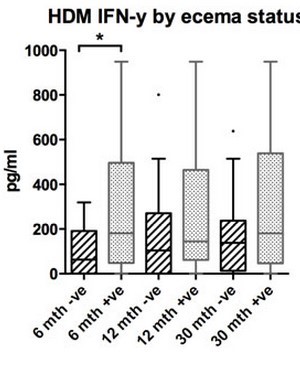Immune System response of infants is associated with higher levels of vitamin D – RCT
25-hydroxyvitamin D3 status is associated with developing adaptive and innate immune responses in the first 6 months of life.
Clin Exp Allergy. 2014 Nov 6. doi: 10.1111/cea.12449. [Epub ahead of print]
Jones A1, D'Vaz N, Meldrum S, Palmer D, Zhang G, Prescott S.
School of Paediatrics and Child Health Research, University of Western Australia; Telethon Kids Institute, University of Western Australia.
A sampling of the charts




BACKGROUND:
Vitamin D (25[OH]D3) status in early life has been linked to the risk of allergic disease in multiple observational studies. While immunomodulating properties are well-recognised there are few longitudinal studies of 25(OH)D3 status, immune function and allergic disease in infants.
OBJECTIVE:
To investigate 25(OH)D3 levels at birth (cord blood [CB]) and at 6 months of age in relation to immune function at 6 months of age, and clinical outcomes up to 30 months of age in infants with a maternal history of atopy.
METHODS:
In a subset of infants (n=225) enrolled in a RCT (ACTRN12606000281594) 25(OH)D3 levels were assessed in relation to peripheral blood mononuclear cell cytokine responses to house dust mite (HDM), ovalbumin (OVA) and β-Lactoglobulin allergens, or toll-like receptor (TLR) ligands (lipopolysaccharide, lipoteichoic acid, polyinosinic:polycytidylic acid and CpG oligonucleotide) at 6 months of age, in addition to clinical outcomes (eczema, wheeze and allergen sensitisation) up to 30 months of age.
RESULTS:
Infants with higher 25(OH)D3 at birth ( >75 nmol/L, compared with <50 nmol/L ) had
- lower IL-5 and IL-13 responses to HDM by 6 months (p<0.001 and p=0.003, respectively).
This was also reflected in strong inverse correlations between
CB 25(OH)D3 levels and
HDM IL-13 (rho=-0.57; p=0.0002) and IL-5 (rho=-0.59, p=0.0001) responses, with a similar trend for
IL-5 (rho=-0.29; p=0.009) responses to OVA.
For innate stimulations , higher 25(OH)D3 levels at 6 months were associated with greater responses to TLR ligands. Additionally, higher CB 25(OH)D3 was associated with reduced risk eczema at 6 months (p= 0.011) and 12 months (p= 0.034),
CONCLUSION: This suggests that improving 25(OH)D3 status in pregnancy or early infancy may reduce the development of allergic disease in high risk infants by inhibiting cytokine profiles associated with allergy . Results of clinical trials are awaited to determine the efficacy of vitamin D supplementation in allergy prevention.
PMID: 25378203
Publisher wants $6 to rent the PDF
See also Vitamin D Life
Incidence of 22 health problems related to vitamin D have doubled in a decade - which has the following

- Crescendo of papers on Asthma, Allergy, and Vitamin D – Sept 2011 which has the following graphic

